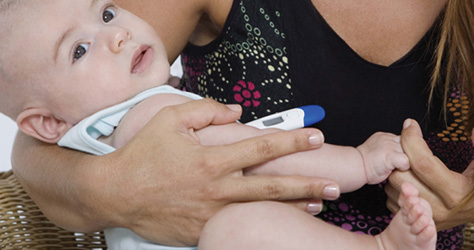You may need to take your baby’s temperature for the first time now, or you might simply want to note, or print out, this information for future reference.
Here's our guide to taking baby's temperature.
At a glance
- Normal temperature and fever
- Signs of a raised temperature
- Taking your baby's temperature

What is a high temperature?
Body temperature will vary slightly for each baby. A normal temperature is generally considered to be around 36.4⁰C (97.4⁰F) and a high temperature is usually considered to be 38⁰C or above.
Signs of a raised temperature:
Your may notice an increased temperature by touching your baby’s forehead, back or stomach. Other signs include sweaty or clammy skin, or flushed cheeks.
Digital Thermometers:
Digital thermometers are widely available in supermarkets and pharmacies, easy to use and should give you the most accurate reading.
Holding your baby comfortably, put the thermometer under their armpit against bare skin, and gently but firmly hold their arm to their body to keep it in place. The instructions on the thermometer will tell you how long to do this for although it’s usually for around 15 seconds.
If your baby has a temperature, and you haven’t already, seek medical advice. If you are unsure about what medicines are safe, you can read our guide here.